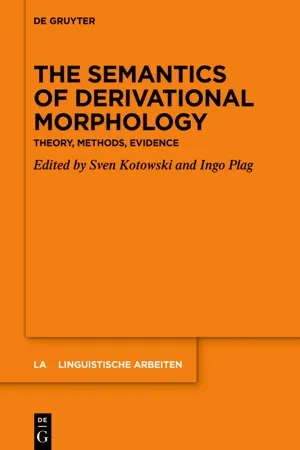
The Semantics of Derivational Morphology
Theory, Methods, Evidence
- 309 pages
- English
- ePUB (mobile friendly)
- Available on iOS & Android
The Semantics of Derivational Morphology
Theory, Methods, Evidence
About this book
This volume brings together cutting-edge research on the semantic properties of derived words and the processes by which these words are derived. To this day, many of these processes remain under-researched and the nature of meaning in derivational morphology remains ill-understood. All eight articles have an empirical focus and rely on carefully collected sets of data. At the same time, the contributions represent a broad variety of approaches. Several contributions deal with specific problems of the pairing of form and meaning, such as the rivalry between nominalizing suffixes or the semantic categories encoded by conversion pairs. Other articles tackle the more general question of how meaning is organized, e.g. whether there is evidence for the paradigmatic organization of derived words or the reality of the inflection-derivation dichotomy. The contributions feature innovative methodologies, such as representing lexical meaning as word distribution or predicting semantic properties by means of analogical algorithms. This volume offers new and highly interesting insights into how complex words mean, and offers directions for future research in an oft-neglected field.
Frequently asked questions
- Essential is ideal for learners and professionals who enjoy exploring a wide range of subjects. Access the Essential Library with 800,000+ trusted titles and best-sellers across business, personal growth, and the humanities. Includes unlimited reading time and Standard Read Aloud voice.
- Complete: Perfect for advanced learners and researchers needing full, unrestricted access. Unlock 1.4M+ books across hundreds of subjects, including academic and specialized titles. The Complete Plan also includes advanced features like Premium Read Aloud and Research Assistant.
Please note we cannot support devices running on iOS 13 and Android 7 or earlier. Learn more about using the app.
Information
Table of contents
- Title Page
- Copyright
- Contents
- The semantics of derivational morphology: Introduction
- Ghost aspect and double plurality: On the aspectual semantics of eventive conversion and -ing nominalizations in English
- Eventualities in the semantics of denominal nominalizations
- The meaning of zero nouns and zero verbs
- Analogical modeling of derivational semantics: Two case studies
- Semantic rivalry between French deverbal neologisms in -age, -ion and -ment
- Quantifying semantic relatedness across base verbs and derivatives: English out-prefixation
- Distributional evidence for derivational paradigms
- Splitting -ly’s: Using word embeddings to distinguish derivation and inflection
- Index